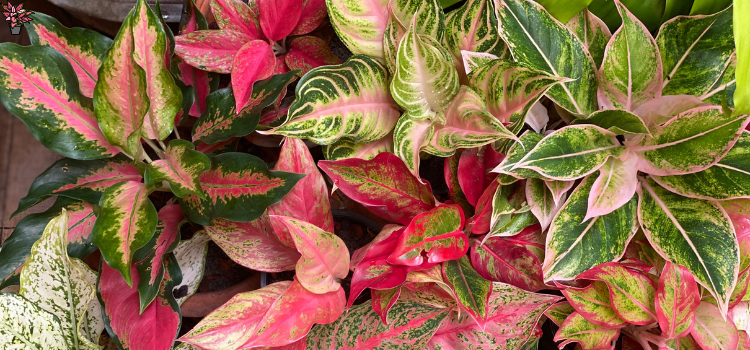
Aglaonema Tissue Culture: Here's What You Should Know
As a content and community manager, I leverage my expertise in plant biotechnology, passion for tissue culture, and writing skills to create compelling articles, simplifying intricate scientific concepts, and address your inquiries. As a dedicated science communicator, I strive to spark curiosity and foster a love for science in my audience.


Introduction to The Aglaonema Plant
Did you know Aglaonema plants are also known as “Chinese Evergreen”? They earned this name for their ability to thrive in low-light conditions. These plants are also highly valued as popular indoor choices, admired for their attractive, variegated leaves.
Aglaonema is a member of the Araceae family and originated in the tropical and subtropical regions of Asia and New Guinea. Its foliage has various shapes, sizes, and color textures, making it strikingly amazing and an attraction for indoor plant lovers.
The captivating genus Aglaonema derives its name from the ancient Greek language. "Aglos" translates to "bright" or "clear," while "nema" signifies "thread," likely referencing the delicate stamens found in its flowers. ThisAglaonema genus boasts a diverse collection of 21 species, with a base chromosome number of x = 6.
Interestingly, many Aglaonema exhibit polyploidy, meaning they possess more than two complete sets of chromosomes (the subsequent number can reach around 52)!
Did you know that many people believe that keeping this plant at home can bring good luck? Yes, that’s why it’s also known as the Luck Plant. This name primarily comes from its association with good fortune in Chinese culture.
In this article, we will discuss the characteristics of Aglaonema plants, the techniques used to grow them, when tissue culture is necessary, and how to perform tissue culture on Aglaonema.
So, let’s get started!
How Do These Plants Look?
Let’s learn about the features of Aglaonema plants.
Aglaonema Plant Characteristics
- Growth Habit: Aglaonemas are perennial plants that can grow upright or as creeping vines. Some species develop aerial roots.
- Leaves: Large, often variegated leaves form a crown-like structure.
- Flowers: Aglaonema produces unisexual flowers arranged on a spadix, enclosed by a spathe.
- Fruit: The plant bears fleshy red berries containing a single large seed.
- Habitat: Thrives in humid, shaded tropical forest environments.

Uses of Aglaonema
Aglaonema, often referred to as the Chinese Evergreen, is a popular choice for indoor gardening.
- Ornamental Value: Prized for its attractive foliage, featuring a variety of colors, patterns, and leaf shapes.
- Low-Light Adaptation: Thrives in low-light conditions, making it ideal for various indoor spaces.
- Air Purification: Certain Aglaonema varieties are known to remove indoor air pollutants like formaldehyde and benzene (as mentioned by NASA clean air study).
- Cultural Significance: Symbolizes luck and prosperity in many Asian cultures.
- Easy Care: Relatively low-maintenance, requiring minimal care to thrive.
However, it's essential to handle Aglaonema with caution as it contains calcium oxalate crystals, which can be irritating if ingested or come into contact with the skin.
Cultivation of Aglaonema
From the striking silver-green leaves of the Silver Bay to the vibrant red accents of the Red Emerald, there's an Aglaonema to suit every aesthetic.
Extensive cultivation and hybridization have resulted in various cultivars tailored to multiple preferences. These adaptable plants thrive in low-light conditions, ideal for diverse indoor environments.
While generally resilient, Aglaonema requires specific care to flourish. Protect them from cold drafts and excessive sunlight, ensuring consistently moist soil without overwatering. Regular fertilization is beneficial, but use caution as oversupplementation can harm the plant. To maintain their vibrant appearance, promptly remove flower stalks.
Aglaonema plants thrive in well-draining soil and appreciate moderate watering. Overwatering can be detrimental, so allow the soil to dry slightly between waterings. To maintain optimal humidity levels, especially in dry indoor environments, consider regular misting.

While these plants are relatively forgiving, individual Aglaonema varieties may have specific care requirements. Therefore, tailoring your care routine based on the specific plant is essential for its long-term health and vitality.
Despite their resilience, Aglaonema can be susceptible to pests like false mites and nematodes, as well as fungal and bacterial diseases. Regular monitoring and appropriate care are essential to prevent issues.
Challenges of Growing Aglaonema Using Traditional Approaches
Sexual reproduction in Aglaonema can be challenging because the flowers often don't bloom at the same time, and the pollen has a short lifespan. Additionally, the resulting offspring can exhibit a wide range of traits due to the segregating population.
For this reason, traditional propagation methods, primarily involving stem cuttings or shoot basal division, have been the norm. While effective, these methods have limitations.
Propagation through cuttings can be slow and potentially transmit diseases from the parent plant. Additionally, some cultivars might harbor pathogens within their vascular tissue, making them potential disease vectors.

Tissue Culture of Aglaonema
Tissue culture addresses the concerns and limitations of conventional plant propagation approaches. It offers an efficient approach if you’re struggling to grow disease-free plants.
For those unfamiliar with tissue culture, it’s a technique that involves growing plants in a lab under sterile, controlled conditions using small sections of plant tissue.
Tissue culture offers multiple benefits:
- Rapid Multiplication: Produces numerous plantlets in a short timeframe.
- Disease-Free Plants: Eliminates the risk of transmitting diseases from parent plants.
- Year-Round Propagation: Unrestricted by seasonal limitations.
- Space Efficiency: Requires minimal space compared to traditional cultivation methods.
- Preservation of Rare Species: Enables the conservation of endangered or rare plants.
- Mass Production: Ideal for commercial cultivation of high-demand plants.
- Genetic Consistency: Produces genetically identical plants, ensuring uniformity.
- Micropropagation: Facilitates the creation of new plant varieties through tissue culture techniques.
Why Tissue Culture Aglaonema?

The development of new cultivars presents an ongoing challenge: rapidly introducing these exciting varieties into the market. This necessitates innovative propagation techniques. Micropropagation (or tissue culture) emerges as a solution.
This advanced vegetative propagation method allows for the production of large quantities of uniform, disease-free plantlets within a short timeframe and limited space. It offers the potential for cultivating healthy stock plants in smaller greenhouses and provides a year-round source of plantlets for growers.
Process of Tissue Culturing Aglaonema
The following procedure is based on a study, but we at PCT haven't tested it in our lab, so we cannot confirm the results obtained. However, if you try the process, do share your experience with us, so we can tweak this information and make it more useful for our tissue culture community.
Plant Material Preparation:
- Selection: Healthy mother plants were selected and maintained under a 50% green shade net, following all recommended crop management practices.
- Pre-Collection Preparation: Irrigation was withheld for one week prior to collection. The plants were sprayed with Blitox (3.0 g/L) and Streptocycline (1.0 g/L) to minimize microbial contamination.
- Explants Collection: Early in the morning, shoot tips and nodal segments were collected. These segments, measuring 1.5 to 2.5 cm, were prepared by removing leaves and exposing dormant buds.
Pre-Treatment and Surface Sterilization:
- Initial Cleaning: The explants were washed under running tap water for one hour to remove surface contaminants.
- Pre-Treatment: Explants were treated with different combinations and concentrations of Carbendazim 0.2%, Mancozeb 0.2%, Plantomycin (200 ppm), and Tween-20.
- Sterilization:
- Sodium Hypochlorite Treatment: The pre-treated explants were dipped in a 4% sodium hypochlorite (NaOCl) solution.
- Mercuric Chloride and Ethanol Treatment: Followed by treatments with 0.1% HgCl2 and 80% ethanol.
- Rinsing: After each chemical treatment, explants were rinsed thrice with autoclaved distilled water to reduce the toxic effects.

Culture Media Preparation:
- Post-Sterilization: The sterilized explants were dried on sterile tissue paper, leaf sheaths and petioles were removed, and a fresh cut was made to expose the tissue.
- Transfer to Media: Explants were then transferred to culture media prepared in test tubes containing Murashige & Skoog media containing varying BAP 2.0 mg/L and NAA 0.5 mg/L, solidified with 7.0 g/L agar-agar.
- pH Adjustment and Sterilization: The media pH was adjusted to 5.8, and then it was sterilized at 121°C for 18 minutes.
Incubation:
- Conditions: After inoculation, explants were incubated in a growth chamber at 26±1°C under a 16-hour light and 8-hour dark cycle with 3000 Lux LED light intensity.
- Observations: Data were recorded for various parameters including contamination rates, explant survival, shoot development, and response time over 25 days.
We hope this process helps you regenerate your favorite Aglaonema plant. And, if you try this, don’t forget to share your experience with us at anjali@plantcelltechnology.com.
Plant Cell Technology Is Your One-Stop-Shop For All Your Tissue Culture Needs
Looking to follow the protocol but are short on supplies? We’ve got you covered.
At Plant Cell Technology, we understand your ambitions and are here to be your trusted partner in creating a thriving home lab.
We understand that setting up a home lab and becoming skilled at the plant tissue culture technique can be challenging. However, with the right tools, knowledge, and support, you can cultivate success and unlock a world of possibilities.
How Plant Cell Technology Empowers You:
- Essential Supplies: Access a comprehensive range of high-quality media, agar, gelling agents, culture vessels, and more to ensure you have the right tools for every step.
- Expert Knowledge: Gain confidence through our informative resources:
- Comprehensive blog articles: Explore topics from basic principles to advanced techniques.
- Master Classes: Immerse yourself in in-depth sessions led by experienced instructors, gain valuable hands-on experience, and master advanced techniques.
- Consultation Services: Our experts will provide personalized advice and custom solutions, ensuring your home lab journey flourishes.
- Community Connection: Join our vibrant community forum to connect with fellow enthusiasts, share experiences, and stay updated on the latest advancements.
Blog Categories
View by Level
Popular Blogs

How Bioreactors Cut Tissue Culture Labor by Half
Introduction Have you ever stopped to calculate the true human and resource cost of every single plantlet leaving your tissue...
Read More
When is Somaclonal Variation a Tool, Not a Flaw?
Introduction Somaclonal variation (SV) is a concept that sits at the very heart of modern plant biotechnology. It is formally...
Read MoreSubscribe to Our Newsletter








Join the conversation
Your email address will not be published. Required fields are marked